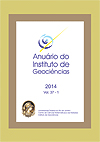Study of Heat Islands in The Metropolitan Area of Rio de Janeiro Using Data from MODIS
DOI:
https://doi.org/10.11137/2014_2_111_122Keywords:
Urban Heat Island, MODIS, Land Surface Temperature.Abstract
The Metropolitan Area of Rio de Janeiro (MARJ) presents a number of environmental problems, among them, the occurrence of Urban Heat Islands (UHI). This paper examines the characteristics of the UHI in the MARJ. For such, 8-days compositions data of Land Surface Temperature (LST), during the period from January 2003 to December 2010, generated by the MODIS (Moderate-resolution Imaging Spectroradiometer) sensor, aboard the Terra and Aqua satellites were used. The data analysis was done by calculating the average LST gathering data for the satellites pass over the seasons, so it could be analyzed more clearly, without cloud contamination. It was observed, some zones presented temperatures close to 50ºC during the spring and summer. Throughout the autumn and winter the average reached 40 º C over most of the study area. During the spring, a 25ºC temperature range was registered between areas with different urbanization levels. In the summer the amplitude was 20ºC between the same areas. In autumn the difference was 15ºC and in winter, 10ºC.Downloads
Download data is not yet available.
Downloads
Published
2017-02-15
How to Cite
Sena, C. A. P., França, J. R. de A. and Peres, L. F. (2017) “Study of Heat Islands in The Metropolitan Area of Rio de Janeiro Using Data from MODIS”, Anuário do Instituto de Geociências. Rio de Janeiro, BR, 37(2), pp. 111–122. doi: 10.11137/2014_2_111_122.
Issue
Section
Article
License
This journal is licensed under a Creative Commons — Attribution 4.0 International — CC BY 4.0, which permits use, distribution and reproduction in any medium, provided the original work is properly cited.















